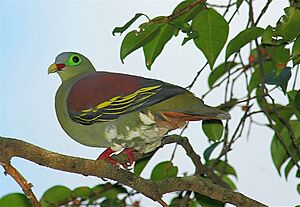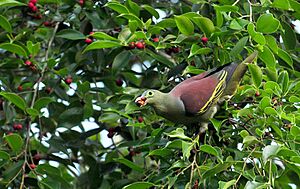Thick-billed green pigeon facts for kids
The thick-billed green pigeon (Treron curvirostra) is a type of bird that belongs to the Columbidae family. This family includes all the doves and pigeons you know! These pigeons are known for their bright green feathers and a special thick bill. They live in many parts of Asia, from the Indian Subcontinent to Southeast Asia.
Quick facts for kids Thick-billed green pigeon |
|
|---|---|
 |
|
| Conservation status | |
| Scientific classification | |
| Genus: |
Treron
|
| Species: |
curvirostra
|
What Does It Look Like?
This pigeon is quite small compared to other green pigeons. It is usually less than 26 centimeters (about 10 inches) long. It has a thick, pale greenish bill with a red part at the base. You can also spot it by its broad, bluish-green ring around its eyes. Its head is grey, and its back has a maroon color.
Its wings are black with yellow edges on the outer feathers. The underside of both male and female pigeons is green. Their thighs are dark green with whitish scales. Male pigeons have a maroon back and dull chestnut feathers under their tail. Females have greenish feathers under their tail with whitish scales.
Where Does It Live?
The thick-billed green pigeon lives across the eastern parts of the Indian Subcontinent and Southeast Asia. You can find them from the Eastern Himalayas all the way to Borneo and Sumatra.
They live in many countries, including Bangladesh, Bhutan, Brunei, Cambodia, Hong Kong, India, Indonesia, Laos, Malaysia, Myanmar, Nepal, the Philippines, Singapore, Thailand, Tibet, and Vietnam.
These birds prefer to live in natural habitats like warm, wet lowland forests. They also like tropical mangrove forests, which are forests that grow in salty water along coasts.
How Does It Behave?
Thick-billed green pigeons are known for what they eat. They love to feed on the fruits of Figs, especially the small, enclosed fruits called syconia. They move slowly along the branches of fig trees while they look for food.
Various Views and Plumages
-
at Jayanti in Buxa Tiger Reserve in Jalpaiguri district of West Bengal, India.
-
at Jayanti in Buxa Tiger Reserve in Jalpaiguri district of West Bengal, India.





